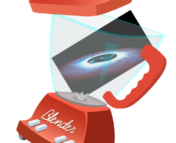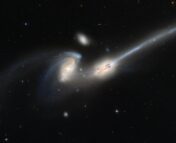Title: GA-NIFS: JWST discovers an offset AGN 740 million years after the Big Bang
Authors: Hannah Übler, Roberto Maiolino, Pablo G. Pérez-González, Francesco D’Eugenio, Michele Perna, Mirko Curti, Santiago Arribas, Andrew Bunker, Stefano Carniani, Stéphane Charlot, Bruno Rodríguez Del Pino, William Baker, Torsten Böker, Giovanni Cresci, James Dunlop, Norman A. Grogin, Gareth C. Jones, Nimisha Kumari, Isabella Lamperti, Nicolas Laporte, Madeline A. Marshall, Giovanni Mazzolari, Eleonora Parlanti, Tim Rawle, Jan Scholtz, Giacomo Venturi, Joris Wistok
First Author’s Institution: Kavli Institute for Cosmology, University of Cambridge, Madingley Road, Cambridge CB3 0HA, UK
Status: Submitted to MNRAS [open access]
Yet another surprise from JWST
On Christmas Day 2021, the James Webb Space Telescope (JWST) was blasted into orbit. In the two years since, we have made one surprising discovery after another. One such surprise is the abundance of systems with multiple black holes in the early Universe.
Black holes lie at the centre of most galaxies, including our very own Milky Way. If two or more black holes are observed close together, this is usually an indication that they are interacting or colliding. Observing these collisions at different points in the history of the Universe is key to understanding how galaxies form and evolve. In today’s paper, the authors present observations of a tantalisingly promising black hole collision over 13 billion years ago – i.e., shortly after the Big Bang in the very, very early Universe!
How to find a black hole
Black holes, by definition, emit and reflect no light (with the exception of Hawking radiation, which in any case is extremely faint). So how do we detect something we can’t ‘see’? For the massive black holes at the centres of galaxies, there are actually multiple methods (for detecting much smaller black holes, see this bite). These black holes are so massive, with gravitational forces so strong, that they accrete huge amounts of matter. This infalling matter heats and lights up, often outshining the host galaxy itself. Such accreting black holes at the hearts of galaxies are called Active Galactic Nuclei (AGN), and studying these AGN is a prominent field of astrophysics.
One such method is looking for specific broad emission lines, since this points to gas with a high temperature and velocity, exactly as expected for matter accreting onto a black hole. In today’s paper, broad Hβ emission was found in a bright region within a galaxy system called ZS7 observed with JWST – a clear indication that this system hosts an AGN.
What’s interesting about ZS7, however, is that slightly offset from this broad-line AGN, we can see evidence of a second AGN (see Figure 1). Unlike the first one, this AGN doesn’t exhibit any broad-line emission. This isn’t too much of a concern – the broad-line emitting region can often be hidden behind huge amounts of dust surrounding the accreting black hole. Instead, astronomers have observed very strong emission of a few key spectral lines. Such strong emission of these lines can only be explained by very high gas temperatures, the likes of which are commonly observed in AGN.
The process of elimination
As exciting as it is to find evidence of two potential AGN within a single system, the authors still have to go through various tests to exclude other possible explanations for what they observe. For example, supernovae explosions can also cause broad Hβ emission. However, the broad-line emission observed in ZS7 is a lot brighter and more symmetrical than what would be typical of a supernova. If it was a supernova, we would also expect the brightness to vary significantly with time, since these colossal explosions emit fast waves of hot gas. Luckily, this system was observed by JWST twice, separated by 5 months. Little to no variation in the brightness is found, further making the supernova scenario very unlikely.
Another possible explanation is the presence of massive stars. Wolf-Rayet stars are a specific type of evolved, massive star that emit broad emission lines due to their high temperatures and powerful stellar winds. Again, the observations of ZS7 disfavour this scenario, since other spectral features typical of Wolf-Rayet stars are not observed.
After a thorough elimination process of many other possible explanations, the authors conclude that ZS7 hosting two AGN is the most likely scenario.

The implications of a dual AGN system
These two AGN are separated by around 620 parsec, which is less than the typical size of a galaxy, and are moving at slightly different velocities. At such a close separation, the two black holes powering these AGN are likely facing an imminent collision. At a redshift of 7.15, this means that this interaction is taking place only 740 million years after the Big Bang, making this amongst the oldest potential black hole collisions observed so far. And this system doesn’t appear to be unique – an increasing number of studies are finding more and more multiple AGN systems in the early Universe.
An increase in the number of black hole collisions as we look further back in time can be explained by the idea of hierarchical structure formation, which essentially suggests that the galaxies (and the supermassive black holes within them) that we observe in the nearby Universe today were formed by the merging of smaller systems (and less massive black holes) in the earlier Universe (also see this and this bite). However, theoretical predictions are somewhat struggling to reconcile with the observations, since we are potentially finding more dual AGN systems than theories predict. Further studies of colliding black holes in the early Universe will therefore help to shed light on how galaxies have evolved over time.
Astrobite edited by Lili Alderson
Featured image credit: Bohn et al. (2015), https://arxiv.org/pdf/1410.7775.pdf




